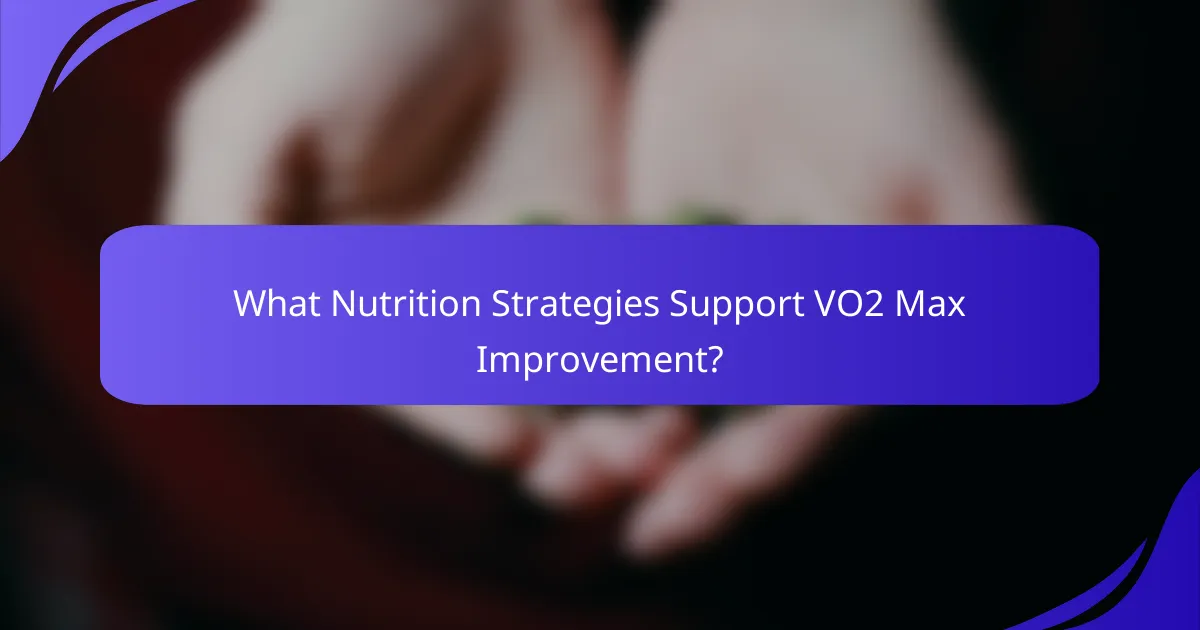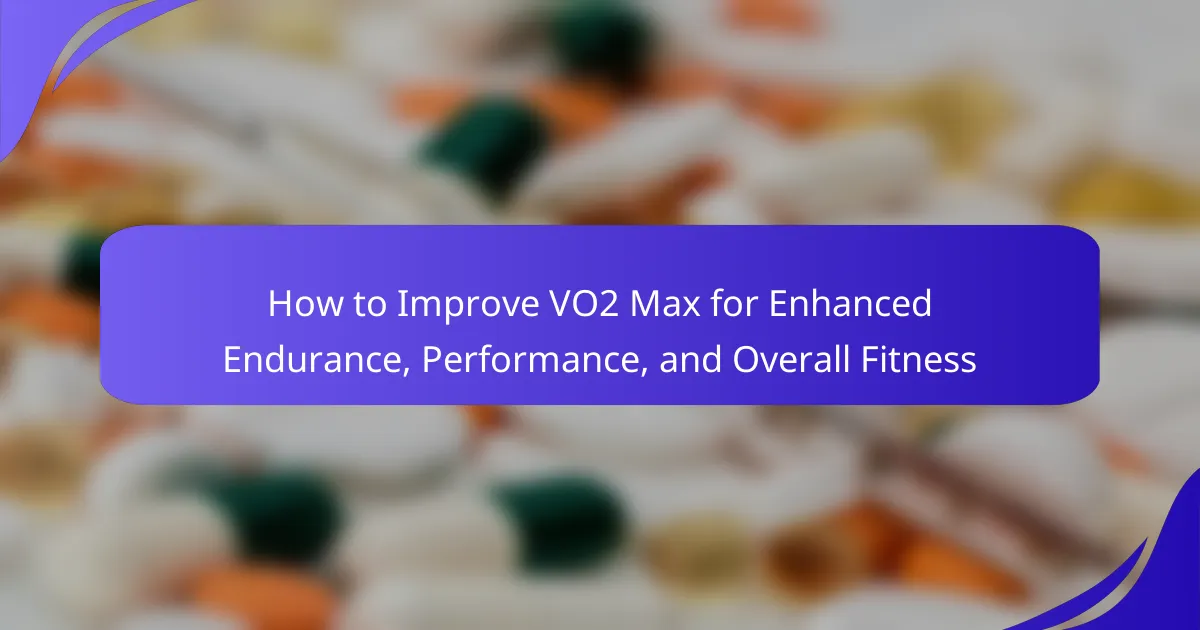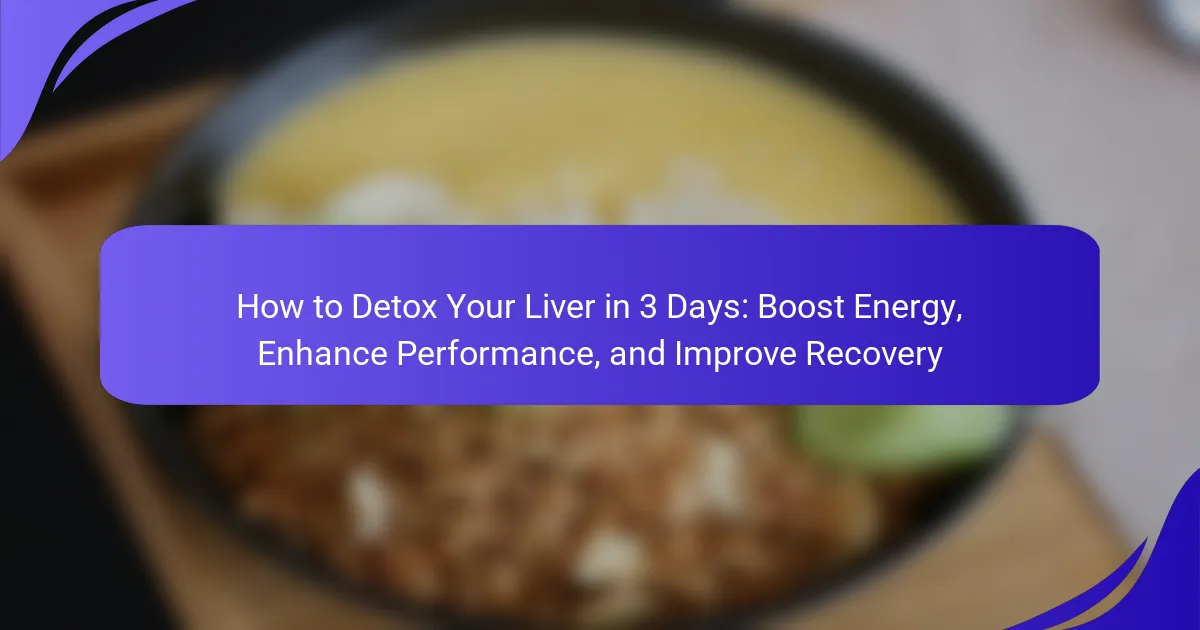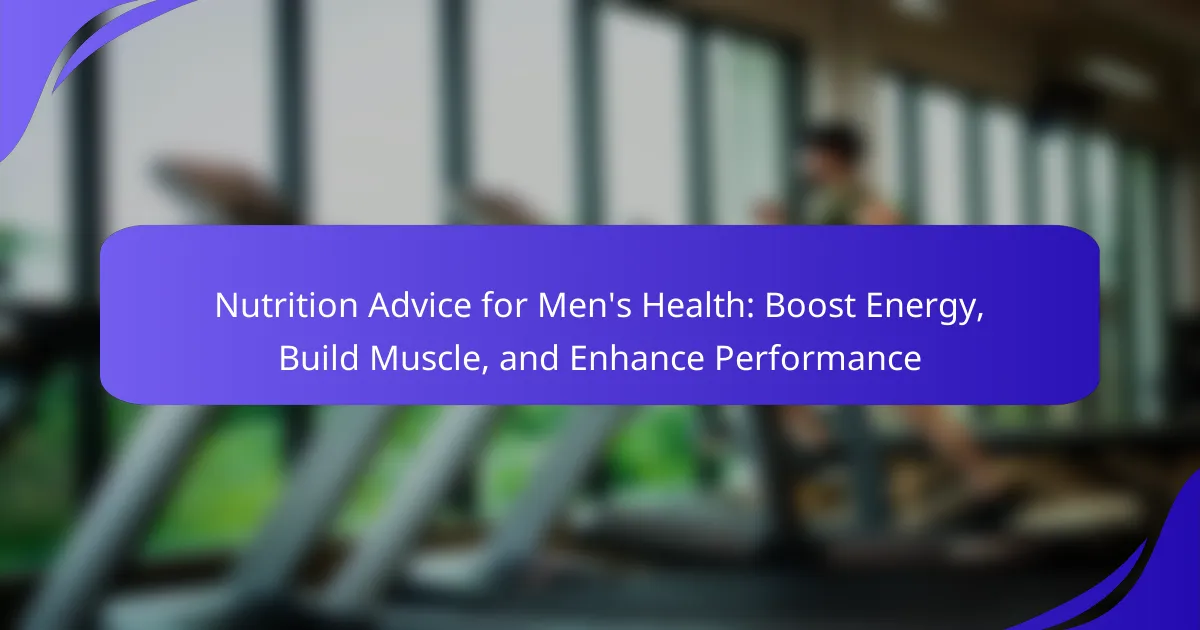Improving VO2 max can significantly enhance endurance, performance, and overall fitness. Key methods include high-intensity interval training (HIIT), continuous aerobic exercise, and strength training. These approaches not only boost cardiovascular capacity but also improve muscle efficiency and recovery times. A balanced diet and proper hydration further support these training efforts for optimal results.

What is VO2 Max and Why is it Important for Endurance?
Improving VO2 max enhances endurance, performance, and overall fitness. Key methods include high-intensity interval training (HIIT), continuous aerobic exercise, and strength training.
HIIT boosts cardiovascular capacity by alternating between intense bursts and recovery phases. Studies show that individuals can increase their VO2 max by 10-30% with consistent HIIT.
Continuous aerobic exercise, such as running or cycling, improves oxygen uptake and utilization. Engaging in sessions lasting 30-60 minutes at moderate intensity can significantly elevate VO2 max over time.
Incorporating strength training enhances muscle efficiency and overall stamina. Research indicates that combining aerobic and resistance training yields superior results in VO2 max improvement compared to aerobic training alone.
How is VO2 Max Measured?
VO2 Max is measured through various methods, primarily using a graded exercise test in a lab setting. This involves increasing exercise intensity while monitoring oxygen consumption. Other methods include field tests, such as the Cooper test, which estimates VO2 Max based on distance covered in a set time. Accurate measurement is critical for assessing endurance and performance improvements.
What Factors Influence VO2 Max?
Several factors influence VO2 max, including genetics, training intensity, and altitude. Genetics plays a crucial role, determining an individual’s baseline aerobic capacity. Training intensity impacts VO2 max improvements; higher intensity workouts yield better results. Additionally, altitude affects oxygen availability, influencing aerobic performance. Regular endurance training can enhance VO2 max over time, emphasizing the importance of consistent exercise for overall fitness.

What are the Universal Benefits of Improving VO2 Max?
Improving VO2 max offers significant benefits for endurance, performance, and overall fitness. Enhanced VO2 max leads to increased aerobic capacity, allowing for longer and more intense workouts.
Higher VO2 max levels correlate with improved cardiovascular health, reducing the risk of heart disease. This enhancement also boosts stamina, enabling athletes to sustain higher intensity efforts for extended periods.
Additionally, improved VO2 max can lead to better recovery times after physical exertion, enhancing overall training efficiency. Athletes with higher VO2 max often experience increased energy levels and improved mental focus during workouts.
Incorporating interval training, aerobic exercises, and proper nutrition can effectively elevate VO2 max, contributing to superior athletic performance and fitness outcomes.
How Does VO2 Max Impact Athletic Performance?
Improving VO2 max significantly enhances athletic performance by increasing oxygen delivery and utilization during exercise. Key methods to boost VO2 max include high-intensity interval training (HIIT), endurance training, and strength training. HIIT has shown to elevate VO2 max by 10-30% in trained athletes. Additionally, incorporating aerobic exercises like running or cycling for at least 150 minutes weekly can further improve cardiovascular efficiency. Adequate recovery, nutrition, and hydration are also vital for maximizing gains in VO2 max, ultimately leading to better endurance and overall fitness.
What Role Does VO2 Max Play in Weight Management?
VO2 max plays a crucial role in weight management by enhancing aerobic capacity and increasing calorie burn during exercise. Improved VO2 max allows individuals to perform at higher intensities for longer periods, which can lead to greater fat loss. Research indicates that higher VO2 max levels correlate with better metabolic health, supporting weight control efforts. Regular aerobic training, such as running or cycling, effectively boosts VO2 max, contributing to improved endurance and overall fitness.

What Unique Training Methods Can Enhance VO2 Max?
High-intensity interval training (HIIT) and tempo runs are unique training methods that can significantly enhance VO2 max. HIIT involves short bursts of intense exercise followed by recovery periods, which effectively increases cardiovascular capacity. Tempo runs maintain a challenging pace over longer distances, improving aerobic threshold and overall endurance. Incorporating these methods into a training regimen can lead to substantial improvements in performance and fitness.
How Does High-Intensity Interval Training (HIIT) Affect VO2 Max?
High-Intensity Interval Training (HIIT) significantly improves VO2 max by enhancing cardiovascular efficiency and oxygen utilization. HIIT involves short bursts of intense exercise followed by rest or low-intensity periods, promoting adaptations in the heart and muscles. Studies indicate that participants can achieve a VO2 max increase of 10-20% within a few weeks of consistent HIIT workouts. This improvement supports enhanced endurance and overall fitness performance.
What are Effective HIIT Workouts for VO2 Max?
Effective HIIT workouts for improving VO2 max include short bursts of high-intensity exercises followed by rest or low-intensity periods. These workouts enhance cardiovascular efficiency and endurance.
1. Tabata: 20 seconds of all-out effort followed by 10 seconds of rest, repeated for 4 minutes.
2. Sprint intervals: 30 seconds of sprinting followed by 1-2 minutes of walking or light jogging, repeated for 20-30 minutes.
3. Circuit training: Combine strength and cardio exercises with minimal rest, maintaining high intensity throughout.
4. Fartlek training: Mix periods of fast running with slower jogging, varying the intensity to challenge your cardiovascular system.
These workouts can significantly boost VO2 max, leading to improved athletic performance and overall fitness.
What is the Role of Endurance Training in VO2 Max Improvement?
Endurance training plays a crucial role in improving VO2 max, which enhances overall performance and fitness. This training increases the body’s ability to utilize oxygen efficiently during prolonged exercise. It stimulates cardiovascular adaptations, such as increased stroke volume and capillary density, which contribute to higher VO2 max levels. Additionally, consistent endurance workouts enhance mitochondrial density in muscle cells, improving energy production. As a result, athletes can sustain higher intensities for longer periods, leading to better performance outcomes.
How to Structure an Endurance Training Program?
To structure an endurance training program effectively, focus on incorporating high-intensity interval training, steady-state cardio, and strength training. Start with a baseline assessment of current fitness levels to tailor the program.
1. Establish a training frequency of 3-5 days per week.
2. Integrate VO2 max workouts, like tempo runs and hill sprints, to enhance aerobic capacity.
3. Include recovery days to prevent overtraining and injury.
4. Monitor progress with regular fitness assessments to adjust the program as needed.
This approach ensures a balanced development of endurance, performance, and overall fitness.

What Rare Techniques Can Lead to Significant VO2 Max Gains?
High-intensity interval training (HIIT) and altitude training are rare techniques that can significantly enhance VO2 max. HIIT involves short bursts of intense exercise followed by rest, leading to improved cardiovascular efficiency. Altitude training exposes the body to lower oxygen levels, stimulating adaptations that boost aerobic capacity. Both methods can yield substantial gains when integrated into a well-structured training program.
How Can Altitude Training Enhance VO2 Max?
Altitude training can significantly enhance VO2 max by improving oxygen uptake and utilization. Training at high altitudes reduces oxygen availability, prompting the body to adapt by increasing red blood cell production. This adaptation enhances overall endurance and performance. Studies indicate that athletes can experience a VO2 max increase of 5-10% after consistent altitude training. Additionally, the unique environmental stressors stimulate physiological changes that improve cardiovascular efficiency. As a result, athletes often report improved performance in lower altitude competitions following altitude training periods.
What is the Impact of Cross-Training on VO2 Max?
Cross-training positively impacts VO2 max by enhancing cardiovascular efficiency and muscular endurance. Incorporating diverse activities like cycling, swimming, and running improves aerobic capacity. Studies show that athletes engaging in cross-training can achieve VO2 max increases of 5-15% over several weeks. This varied approach prevents plateaus and reduces injury risk, contributing to overall fitness and performance.

What Nutrition Strategies Support VO2 Max Improvement?
A balanced diet rich in carbohydrates, proteins, and healthy fats supports VO2 max improvement. Prioritize complex carbohydrates for energy, lean proteins for muscle repair, and omega-3 fatty acids for inflammation reduction.
Hydration plays a crucial role in optimizing performance and oxygen delivery. Aim for adequate fluid intake before, during, and after exercise to maintain endurance and recovery.
Timing of nutrient intake can enhance VO2 max. Consuming carbohydrates and proteins before and after workouts aids in energy levels and muscle recovery, maximizing training benefits.
Consider supplements like beetroot juice, which may improve blood flow and oxygen delivery, potentially enhancing VO2 max. Incorporate these strategies into a comprehensive training plan for optimal results.
What Nutrients are Essential for Optimal Performance?
To improve VO2 max for enhanced endurance and performance, essential nutrients include carbohydrates, proteins, and fats. Carbohydrates provide energy for high-intensity workouts, while proteins support muscle repair and growth. Healthy fats contribute to sustained energy levels during prolonged exercise. Additionally, vitamins and minerals, such as vitamin D and magnesium, play crucial roles in energy metabolism and muscle function. A balanced intake of these nutrients can optimize overall fitness and performance.
How to Time Nutrition Around Workouts for Best Results?
To optimize VO2 max, time nutrition strategically around workouts. Pre-workout, consume carbohydrates for energy and protein for muscle support. Post-workout, prioritize protein intake to aid recovery and replenish glycogen stores. Aim for a balanced meal within 30 minutes after exercising.

What are Common Mistakes to Avoid When Training for VO2 Max?
To improve VO2 max effectively, avoid common mistakes like inadequate intensity, neglecting recovery, and poor nutrition. Focusing on consistent high-intensity interval training (HIIT) is essential. Additionally, ensure proper hydration and a balanced diet to support endurance training. Prioritize rest days to allow for muscle recovery, as overtraining can hinder progress.
How to Identify Overtraining Symptoms?
To identify overtraining symptoms, monitor physical and psychological indicators. Common signs include persistent fatigue, decreased performance, and mood swings. Pay attention to changes in sleep patterns and increased susceptibility to illness. Regular self-assessment can help detect these issues early.
What are the Myths Surrounding VO2 Max Training?
Many myths surround VO2 max training, often leading to misconceptions about its effectiveness. One common myth is that only elite athletes can significantly improve their VO2 max, but research shows that individuals at all fitness levels can enhance their aerobic capacity through targeted training. Another myth suggests that high-intensity interval training (HIIT) is the only effective method to boost VO2 max; however, steady-state cardio also plays a crucial role. Additionally, some believe that simply increasing workout duration will automatically raise VO2 max, neglecting the importance of intensity in training. Understanding these myths can help individuals adopt a more effective approach to improving their endurance and overall fitness.

What Expert Insights Can Help Maximize VO2 Max Benefits?
To maximize VO2 max benefits, incorporate high-intensity interval training (HIIT) into your routine. HIIT significantly boosts cardiovascular efficiency and endurance. Research shows that participants can improve VO2 max by 10-30% through consistent HIIT sessions. Additionally, strength training enhances muscle oxygen utilization, complementing aerobic efforts. Aim for a balanced approach, integrating both training types for optimal results.
What Recovery Techniques Aid in VO2 Max Improvement?
Active recovery techniques, such as low-intensity exercise and stretching, significantly aid in VO2 max improvement. These methods enhance blood flow, reduce muscle soreness, and promote recovery, allowing for more effective training sessions. Incorporating techniques like foam rolling and yoga can also improve flexibility and endurance. Regular use of these recovery strategies supports sustained performance gains and overall fitness enhancement.
How to Monitor Progress Effectively?
To monitor progress effectively in improving VO2 max, track specific metrics consistently. Use a heart rate monitor during workouts to gauge intensity and recovery. Measure your VO2 max through periodic fitness tests or estimates from running pace. Record workout durations and intensities to analyze trends over time. Set specific, measurable goals to maintain motivation and adjust your training regimen based on progress.
What are the Best Practices for Sustaining VO2 Max Gains?
To sustain VO2 max gains, incorporate regular high-intensity interval training (HIIT), maintain consistent aerobic exercise, and ensure adequate recovery. Focus on progressive overload by gradually increasing intensity or duration, while also monitoring nutrition to support energy levels. Aim for at least three sessions per week, blending various workout styles to prevent adaptation.



